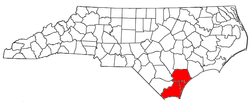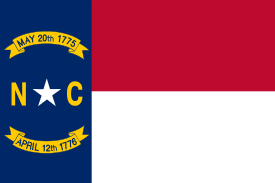Cape Fear (region)
Cape Fear is a coastal plain and Tidewater region of North Carolina centered about the city of Wilmington.[1] The region takes its name from the adjacent Cape Fear headland, as does the Cape Fear River which flows through the region and empties into the Atlantic Ocean near the cape. Much of the region's populated areas are found along the Atlantic beaches and the Atlantic Intracoastal Waterway, while the rural areas are dominated by farms and swampland like that of the Green Swamp. The general area can be also identified by the titles "Lower Cape Fear", "Wilmington Metropolitan Area", "Southeastern North Carolina", and "Azalea Coast". The latter name is derived from the North Carolina Azalea Festival held annually in Wilmington. Municipalities in the area belong to the Cape Fear Council of Governments.

The region is home to the Port of Wilmington, the busiest port in North Carolina, operated by the North Carolina State Ports Authority. It is also the location of Military Ocean Terminal Sunny Point, the largest ammunition port in the nation, and the U.S. Army's primary East Coast deep-water port. Plans are underway for the construction of the North Carolina International Port in the region on the west bank of the Cape Fear River as an expansion of the Port of Wilmington.
Geography
The Cape Fear region is situated on the Atlantic Coastal Plain. A large portion of the region is low-lying wetlands, most notably the Green Swamp, which is one of the rare habitats of the Venus flytrap. The Cape Fear River and the Northeast Cape Fear River are the deeper prominent rivers that flow through the region, with minor rivers like the Lockwood Folly River, Brunswick River, and Shallotte River providing access for small watercraft of small communities.
| Climate data for Wilmington Int'l, North Carolina (1981–2010 normals, extremes 1870–present)[lower-alpha 1] | |||||||||||||
|---|---|---|---|---|---|---|---|---|---|---|---|---|---|
| Month | Jan | Feb | Mar | Apr | May | Jun | Jul | Aug | Sep | Oct | Nov | Dec | Year |
| Record high °F (°C) | 82 (28) |
85 (29) |
94 (34) |
95 (35) |
101 (38) |
104 (40) |
103 (39) |
103 (39) |
100 (38) |
98 (37) |
87 (31) |
82 (28) |
104 (40) |
| Mean maximum °F (°C) | 73.7 (23.2) |
76.1 (24.5) |
82.0 (27.8) |
87.1 (30.6) |
91.6 (33.1) |
95.8 (35.4) |
96.8 (36.0) |
95.9 (35.5) |
91.8 (33.2) |
86.5 (30.3) |
81.2 (27.3) |
75.4 (24.1) |
98.2 (36.8) |
| Average high °F (°C) | 56.4 (13.6) |
59.9 (15.5) |
66.4 (19.1) |
74.2 (23.4) |
80.7 (27.1) |
86.9 (30.5) |
89.7 (32.1) |
88.1 (31.2) |
83.7 (28.7) |
75.7 (24.3) |
68.0 (20.0) |
59.3 (15.2) |
74.1 (23.4) |
| Average low °F (°C) | 35.6 (2.0) |
37.9 (3.3) |
43.8 (6.6) |
51.6 (10.9) |
60.0 (15.6) |
68.7 (20.4) |
72.6 (22.6) |
71.3 (21.8) |
65.6 (18.7) |
54.6 (12.6) |
45.4 (7.4) |
37.8 (3.2) |
53.8 (12.1) |
| Mean minimum °F (°C) | 18.5 (−7.5) |
22.7 (−5.2) |
28.2 (−2.1) |
35.4 (1.9) |
45.6 (7.6) |
57.1 (13.9) |
64.3 (17.9) |
62.7 (17.1) |
52.9 (11.6) |
38.7 (3.7) |
29.6 (−1.3) |
21.1 (−6.1) |
15.7 (−9.1) |
| Record low °F (°C) | 5 (−15) |
5 (−15) |
9 (−13) |
28 (−2) |
35 (2) |
48 (9) |
54 (12) |
55 (13) |
42 (6) |
27 (−3) |
16 (−9) |
0 (−18) |
0 (−18) |
| Average precipitation inches (mm) | 3.76 (96) |
3.62 (92) |
4.21 (107) |
2.82 (72) |
4.49 (114) |
5.18 (132) |
7.48 (190) |
7.41 (188) |
7.84 (199) |
3.89 (99) |
3.29 (84) |
3.62 (92) |
57.61 (1,463) |
| Average snowfall inches (cm) | 0.4 (1.0) |
0.3 (0.76) |
0.2 (0.51) |
0 (0) |
0 (0) |
0 (0) |
0 (0) |
0 (0) |
0 (0) |
0 (0) |
0 (0) |
0.8 (2.0) |
1.7 (4.3) |
| Average precipitation days (≥ 0.01 in) | 10.2 | 9.5 | 10.0 | 8.5 | 10.9 | 12.8 | 16.4 | 15.9 | 12.8 | 9.0 | 9.2 | 9.4 | 134.6 |
| Average snowy days (≥ 0.1 in) | 0.3 | 0.3 | 0.1 | 0 | 0 | 0 | 0 | 0 | 0 | 0 | 0 | 0.3 | 1.0 |
| Average relative humidity (%) | 70.7 | 68.4 | 69.1 | 66.8 | 73.7 | 76.3 | 78.3 | 80.7 | 79.9 | 75.9 | 73.2 | 71.5 | 73.7 |
| Mean monthly sunshine hours | 181.5 | 182.1 | 238.0 | 276.3 | 285.3 | 280.1 | 280.7 | 254.3 | 230.0 | 229.3 | 197.4 | 181.1 | 2,816.1 |
| Percent possible sunshine | 58 | 59 | 64 | 71 | 66 | 65 | 64 | 61 | 62 | 65 | 63 | 59 | 63 |
| Source: NOAA (relative humidity and sun 1961–1990)[2][3][4] | |||||||||||||
Counties
Three counties form the core of the Cape Fear region: Brunswick County (since 2009 part of the Myrtle Beach metropolitan area), New Hanover County, and Pender County. As of the 2000 census, the three counties had a combined population of 274,532, at which time all were part of the Wilmington metropolitan area. In 2010 the population of the three counties was 362,315.[5][6][7] The coastal communities boast a large, seasonal tourism industry leading to much higher populations in the summer months and lower populations in the winter months.
Two additional counties, Bladen and Columbus, are occasionally included as part of the Cape Fear region, as are Duplin, Onslow, and Sampson counties, but to a lesser extent.
Communities
These are communities found in the metropolitan statistical area.
Cities
- Boiling Spring Lakes
- Northwest
- Southport
- Wilmington (principal city)
Towns
Former towns
Villages
Census-designated places
Unincorporated places
- Ash
- Charity
- Currie
- Figure Eight
- Montague
- Murphey
- Piney Grove
- Register
- Sloop Point
- Supply
- Winnabow
- Yamacraw
Demographics
As of the census[8] of 2000, there were 274,532 people, 114,675 households, and 75,347 families residing within the metropolitan statistical area (MSA). The racial makeup of the MSA was 79.47% White, 17.27% African American, 0.48% Native American, 0.58% Asian, 0.05% Pacific Islander, 1.12% from other races, and 1.02% from two or more races. Hispanic or Latino of any race were 2.45% of the population.
The median income for a household in the MSA was $37,321, and the median income for a family was $44,844. Males had a median income of $32,454 versus $22,998 for females. The per capita income for the MSA was $20,287.
See also
Notes
- Official snowfall records for Wilmington were kept at the Weather Bureau in downtown from December 1870 to September 1951, and at Wilmington Int'l since October 1951. Precipitation, minimum temperature, and maximum temperature records date to 1 January 1871, 1 March 1873, and 1 April 1874 respectively.[2] For more information, see ThreadEx.
References
- "Lower Cape Fear Historical Society". Archived from the original on 2009-08-13. Retrieved 2009-08-13.
- "NowData: NOAA Online Weather Data". National Oceanic and Atmospheric Administration. Retrieved 2019-10-04.
- "Station Name: NC WILMINGTON INTL AP". National Oceanic and Atmospheric Administration. Retrieved 2018-10-01.
- "WILMINGTON WSO AP, NC Climate Normals 1961–1990". National Oceanic and Atmospheric Administration. Retrieved December 4, 2012.
- "Geographic Identifiers: 2010 Census Summary File 1: Brunswick County, North Carolina". American Factfinder. United States Census Bureau, Population Division. Archived from the original on February 13, 2020. Retrieved April 9, 2018.
- "Geographic Identifiers: 2010 Census Summary File 1: New Hanover County, North Carolina". American Factfinder. United States Census Bureau, Population Division. Archived from the original on February 13, 2020. Retrieved April 9, 2018.
- "Geographic Identifiers: 2010 Census Summary File 1: Pender County, North Carolina". American Factfinder. United States Census Bureau, Population Division. Archived from the original on February 13, 2020. Retrieved April 9, 2018.
- "U.S. Census website". United States Census Bureau. Retrieved 2008-01-31.

